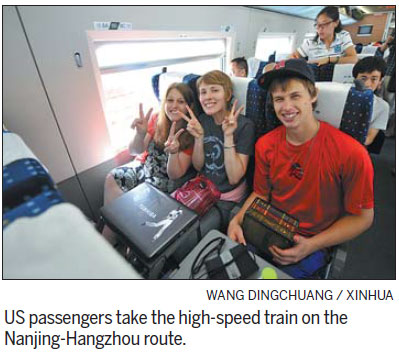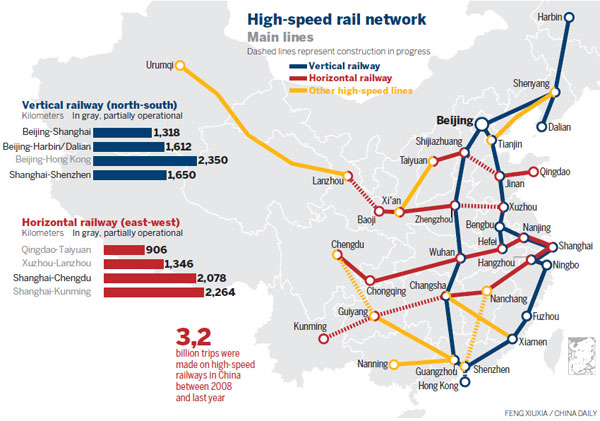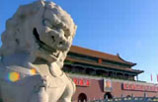On the global fast track
Updated: 2015-04-10 07:17
By Zhao Lei(China Daily Europe)
|
|||||||||||
China's innovation and expertise in high-speed rail open new doors to export opportunities, Zhao Lei reports
China is in discussions with more than 20 nations including the United States, Russia, Brazil and Thailand on the export of high-speed railway technology and products, an industry insider says.
"As one of the achievements of China's innovation effort, the high-speed railway has become our country's label and representative in the international community," says Jia Shirui, vice-president of China CNR Corp. The country's two largest train makers, CNR and CSR Corp, have announced a merger plan on Dec 30 to become the world's largest train manufacturer.

"We already have the proper conditions and due advantages to promote our high-speed railway technology and products in the international market," he says. "High-speed rail transportation features low consumption of resources and high environmental performance, making it a sensible choice for many countries, and they know we have excellent technological capability, rich experience as well as competitive prices in this field."
Jia says that Chinese enterprises should pay more attention to their overseas projects' profitability, because high-speed railway construction usually requires a large amount of investment and takes a long time.
During a State Council meeting on Jan 28, Premier Li Keqiang urged government departments to boost the overseas expansion of Chinese-developed industrial equipment, including high-speed railway.
The export of such equipment will help generate new growth opportunities in China's international trade and upgrade related sectors, according to a statement released after the meeting.

In an attempt to further tap the market, China Railway Corp, successor of the former railway ministry, established China Railway International Ltd earlier this year to coordinate Chinese companies' overseas development.
The company is also pushing forward the development of a series of Chinese-standard bullet trains to make sure that China is able to promote its own intellectual properties and use them to advantage in the global market.
An engineer close to China Railway Corp, who insisted on anonymity, says the company's China Academy of Railway Sciences is leading the trains' development while the train makers have been commissioned to develop a 350-kph train.
Currently, bullet trains running on the country's high-speed rail network have been designed and built in accordance with foreign standards, the engineer says, adding that the absence of Chinese-standard bullet trains has generated obstacles for the nation's efforts to export its high-speed railway technology and products.
Zhao Jian, a professor at Beijing Jiaotong University who specializes in China's railway system, says that although Chinese factories can produce almost all bullet train parts, many major technologies are still licensed from foreign railway giants.
As the government has poured huge investment into research and development, Chinese engineers are catching up in some important fields.
Their latest achievement is a permanent magnet synchronous traction system that was developed by China CSR Corp at its Zhuzhou Institute in Hunan province.
It has passed preliminary examination by national railway test authorities and has been installed on a new bullet train for a trial run, according to Jia Limin, a professor at Beijing Jiaotong University who heads China's high-speed railway innovation program.
For its part, the National Railway Administration released China's first design specification standards for high-speed railways in December. The standards govern nearly 20 fields involved in the design and construction of lines for bullet trains running at a speed of 250 to 350 kph.
The specifications will provide a technical foundation for the nation's development of a high-speed railway network and facilitate its export efforts, the administration says.
During visits to Asia, Africa, Australia and Europe, Li told foreign government leaders, railway planners and company executives that China's high-speed railway technologies are safe, reliable and economically competitive, and that China is willing to enhance cooperation in the railway sector.
Largely due to his promotion, Chinese enterprises have been selected to take part in the construction of a high-speed rail line between Belgrade, Serbia, and Budapest, Hungary, and a modern route to link Mombasa and Nairobi in Kenya. A high-speed railway research and development center will also be set up in Africa.
Last fall, Li and his Russian counterpart, Dmitry Medvedev, witnessed the signing of an agreement in Moscow that urges Chinese and Russian companies to hold talks on the design, financing, supply and construction of a 770-kilometer, high-speed line connecting Moscow and Kazan, an important metropolis on the Volga River.
Under Russia's plan, the line will form the initial section of a railway stretching to Beijing, with completion scheduled for 2018 in time for the FIFA World Cup in Russia. Kazan will be one of the host cities.
China has also included three rail lines that link the country to Southeast Asian nations in its medium and long-term railway network plan, and its engineers have begun to conduct some preliminary work, according to sources close to China Railway Corp.
With their technological and engineering capabilities advancing rapidly, Chinese railway enterprises have found that projects in developing nations can no longer satisfy their growing ambitions. They have begun to knock on the doors of some developed countries that once looked down on Chinese railway technology.
During a visit to California in October, a delegation of Chinese officials and representatives of Chinese high-speed railway companies discussed with their US counterparts the possibility of China's participation in California's high-speed rail project.
"We want to learn about the high-speed rail policies and the investment environment in California, and introduce Chinese high-speed rail products and technology to our California friends," says Zhang Yujing, president of the China Chamber of Commerce for Import and Export of Machinery and Electronic Products and head of the delegation. "By doing so, we want to promote discussions to create better business opportunities."
Jeff Morales, CEO of the California Rail Authority, says: "We are very impressed by China's great progress and leadership in high-speed rail. China has built 7,000 miles of high-speed rail, the US has built zero, but we will change that. California will be the first high-speed rail system in the US."
Similarly, in the United Kingdom, Chinese enterprises are negotiating with their British partners on possible collaboration in local high-speed railway projects, according to Liu Xiaoming, China's ambassador to the UK.
Wang Mengshu, a tunnel and railway expert at the Chinese Academy of Engineering, says China has rich expertise and experience in designing, building and operating a high-speed rail network, so the nation should be an ideal option for any foreign countries that want to build their own high-speed rail lines.
China is the only nation in the world that has carried out large railway projects over the past decade, and some of the projects were built in harsh environments such as the high-altitude Qinghai-Tibet Plateau and in bitterly cold Northeast China, testifying to the country's strong capability in this field, he says.
In addition, Wang says, China uses a flexible approach toward funding cooperative programs, encouraging foreign nations with financial difficulties to repay their share of the investment with local resources.
The previous success of Chinese railway companies will help them obtain contracts for high-speed railway projects in the US and Brazil in the near future, according to Feng Hao, a transportation researcher with China's National Development and Reform Commission.
By the end of last year, the nation had built a high-speed rail network of more than 16,000 kilometers, far exceeding that in any other country and larger than the high-speed rail network in the European Union, Chinese government statistics show.
Contact the writer at zhaolei@chinadaily.com.cn



(China Daily European Weekly 04/10/2015 page16)
Today's Top News
Putin backs China's Silk Road proposal
Boston bomber convicted, may face death penalty
Zhou trial likely to serve as model
Belarus to expand trade and economic ties with China
Cause of China chemical plant blast identified
Fleeing war-torn Yemen, Chinese, foreign nationals share the same boat
Liu Xiang expected to announce retirement on Tuesday
Toilet revolution for tourism evolution: Opinion
Hot Topics
Lunar probe , China growth forecasts, Emission rules get tougher, China seen through 'colored lens', International board,
Editor's Picks

|

|

|

|

|

|






